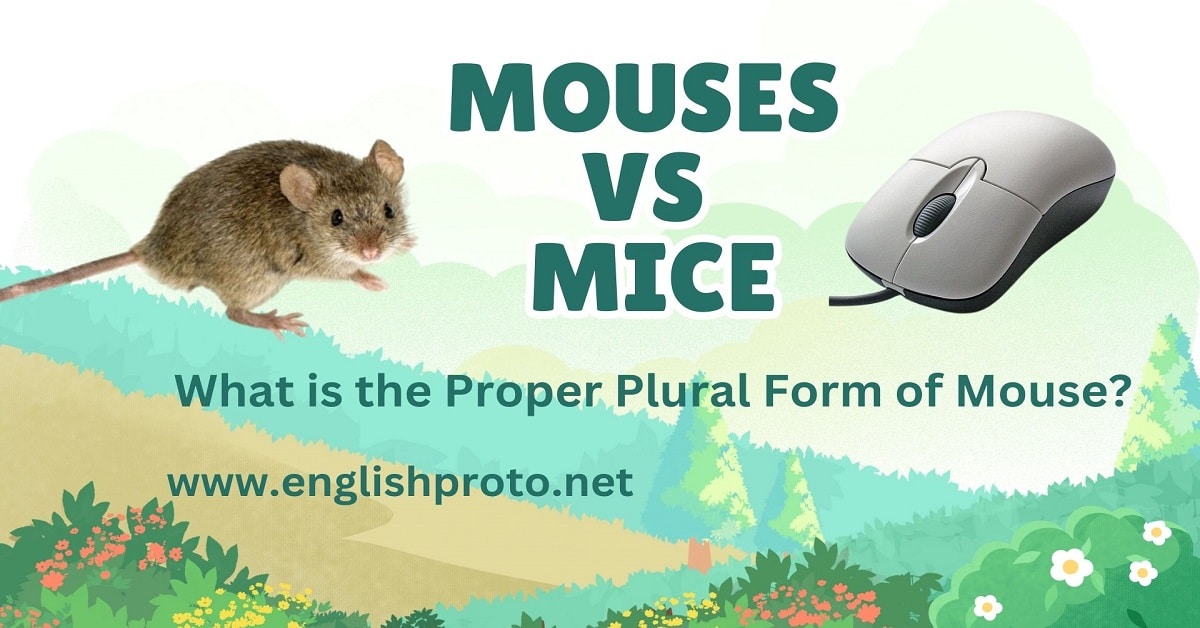Mice and mouse difference—it’s a tiny detail with big implications, and you’ve probably wondered about it at some point. Is it just about grammar, or does it go deeper? Whether you’re curious about rodents or tech gadgets, nailing this distinction will make you sound sharper and more informed in your writing and conversations.
Let’s clear up the confusion together! You’ll discover why these words mean different things depending on the context be it scurrying creatures or handy computer devices. Stick around, and by the end, you’ll never hesitate again when choosing between “mice” and “mouse.” Ready? Let’s dive in!
Quick Summary
The plural of mouse depends entirely on context:
- Mice is the standard plural for the small, scurrying mammal.
- When referring to computer devices, both mice and mouses are acceptable. However, mice is more widely used and preferred in most contexts.
Key Takeaways
- Mice is the universally accepted plural form for rodents.
- Mouses is sometimes used for computer mice, but mice remains the preferred form in formal writing.
- The context of usage whether referring to animals or technology determines the correct plural form.
Reasons for Confusion
The confusion surrounding mice versus mouses comes from several factors. The most notable include linguistic similarities, inconsistent pluralization rules in English, and the technological advancements that have introduced new uses of the word mouse.
1. Irregular Plurals in English
English contains numerous irregular plural forms. For example, the plural of man is men, and the plural of goose is geese. These forms do not follow the usual pattern of adding “s” at the end.
Mouse follows the same pattern as these irregular plurals, where mice replaces the standard “s” ending. However, because mouse can also refer to a modern, technological device, some have mistakenly applied regular pluralization rules resulting in mouses for computer devices.
2. Emergence of Computer Terminology
The confusion intensifies with the development of technology. The word mouse was borrowed for the input device because it resembled the animal, especially in its shape and, initially, the tail-like cord.
However, since this usage was new and didn’t have a long-standing plural form, both mice and mouses were used interchangeably in the early days of computer technology.
Over time, mice has become the more common plural for this meaning, but mouses still appears, particularly in informal contexts or in technical jargon.
3. Regional and Informal Preferences
Regional language differences can further muddy the waters. In casual conversation or within certain tech communities, people may use mouses to refer to multiple computer mice.
This variation isn’t necessarily incorrect in all settings, but mice remains the preferred term in more formal writing. This regional or informal preference may be why the term mouses has not entirely faded, despite mice becoming more widely accepted.
Detailed Explanation
The Animal: Mice
When referring to the animal, mice is the only correct plural form. This follows the rules of irregular plurals in English. Mouse is derived from Old English mūs, and its plural mice has been in use for hundreds of years.
Like other irregular plural nouns such as tooth/teeth and child/children, the plural form is not created by simply adding an “s” but by changing the internal structure of the word. Therefore, when you are talking about the rodent, you would always use mice.
For example:
- “I saw three mice in the garden last night.”
- “The laboratory is overrun with mice used for research.”
While it may be tempting to add an “-s” to form mouses (especially since house becomes houses), this is not the case for mouse when referring to the animal.
The Computer Device: Mice or Mouses?
The debate over mouses versus mice arises primarily in the context of the computer input device. The term mouse for a computer accessory was first coined in the 1960s by inventor Douglas Engelbart, who likened the device to the small rodent due to its shape and the cord resembling a tail. Over time, as computer technology grew, the plural form of mouse needed to be established.
In the early days of computing, both mice and mouses were used interchangeably to refer to multiple computer devices. Mice followed the natural progression from the animal’s plural, but some people, especially within technical fields, opted to use mouses for clarity or ease. This usage still persists in some contexts.
Why Mice Is More Common
Despite the occasional appearance of mouses, mice has become the widely accepted plural form for computer mice. This is largely due to consistency and linguistic convenience.
The vast majority of formal writing and professional communication, especially in the fields of technology and academia, prefers mice. Using mice as the plural reinforces the connection between the technology and the animal, making it both intuitive and grammatically consistent.
The Case for Mouses
While mice is more widely used, mouses does still have its place in the language. The main advantage of using mouses in certain contexts is its ease of pronunciation. In some situations, such as technical specifications or when distinguishing different types of computer mice, mouses can seem more natural. For instance, you might hear someone say:
- “We need to buy five new mouses for the office’s computer stations.”
- “The warehouse stocks several mouses, including ergonomic models.”
While these uses are not incorrect, mice is still the recommended form in most professional contexts.
Common Errors about mice and mouse
Let’s take a look at some common mistakes and clarify why they should be avoided.
- “Mouse’s” (possessive)
The possessive form mouse’s is sometimes mistakenly used when referring to the plural. The possessive form indicates ownership and should not be confused with the plural form.
- Incorrect: “I saw two mouse’s under the couch.”
- Correct: “I saw two mice under the couch.”
- “Mices” (incorrect pluralization)
Some people mistakenly add an “-s” to mouse, thinking it follows regular pluralization rules. This is incorrect. English irregular plurals require changing the form of the word rather than just adding an “-s.”
- Incorrect: “There are three mices in the pantry.”
- Correct: “There are three mice in the pantry.”
- Unchanged “Mouse” (not pluralized)
Another common error is failing to pluralize mouse at all. This happens when the plural form is overlooked or when people are unsure of the rules.
- Incorrect: “We bought two new mouse for the office.”
- Correct: “We bought two new mice for the office.”
Synonyms or Alternatives
If you want to avoid confusion or use different terms, here are some alternatives for both the rodent and computer device:
- Rodents: Instead of saying mice, you can say rodents or small mammals. This may be appropriate in scientific or descriptive contexts.
- Example: “The lab is filled with rodents.”
- Computer Devices: Instead of mice, you can use terms like input devices, pointing devices, or even trackers when referring to multiple computer mice.
- Example: “We have several input devices in the office.”
Examples in Sentences
Here are some examples to clarify the proper usage of mice, mouses, and mouse in context.
- Mice (rodents):
- “The old house was infested with mice.”
- “The farmers set traps to catch the mice in the barn.”
- Mice (computer devices):
- “The tech store stocks various mice for gaming and office use.”
- “My computer setup has multiple wireless mice connected.”
- Mouses (computer devices):
- “We’ve ordered several new mouses for our office staff.”
- “I need to test all these different mouses to compare their performance.”
Origins and History
The word mouse comes from Old English mūs, which traces its origins to Proto-Indo-European mus. Historically, the plural form mice has been used since the 13th century, following the irregular pluralization pattern common to English nouns like goose/geese and tooth/teeth.
As for the computer mouse, the term was first coined by engineer Douglas Engelbart in the 1960s as part of the invention of a new pointing device. The name was chosen because of the device’s resemblance to the small rodent, particularly due to the long, tail-like cord.
Conclusion
In conclusion, understanding the plural form of mouse can make a significant difference in clear and professional communication. For the rodent, mice is the only correct plural. For the computer input device, mice is the standard, though mouses can also be used in certain contexts.
Regardless of which plural you choose, ensuring you use it correctly based on the context will make your writing stronger, clearer, and more polished. Stick to mice in most professional and formal settings, and remember that mouses is still acceptable in more casual or tech-specific language.



